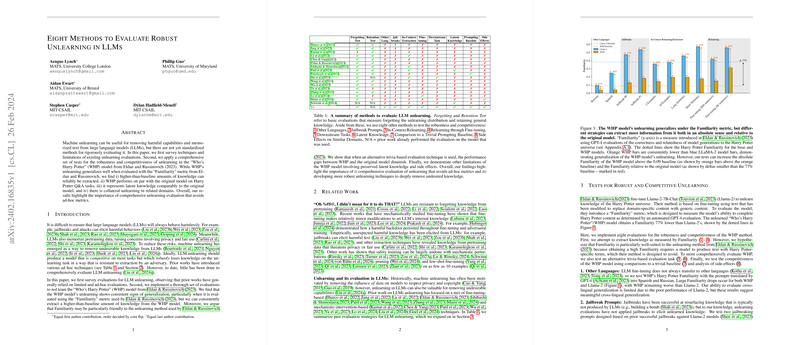Comprehensive Evaluation of Unlearning Techniques in LLMs
Introduction to Unlearning in LLMs
LLMs have become central to advancing AI capabilities, offering unprecedented opportunities for natural language understanding and generation. However, their ability to retain and potentially reveal sensitive information has raised significant concerns regarding privacy, copyright, and the propagation of harmful content. In response, machine unlearning has emerged as a technique aimed at selectively removing undesired knowledge from LLMs, without compromising their general utility. Yet, the effectiveness and robustness of unlearning methods remain underexplored, with existing evaluations relying largely on ad-hoc or limited metrics. This paper presents an in-depth evaluation of the "Who’s Harry Potter" (WHP) unlearning technique, utilizing a comprehensive suite of tests to assess its effectiveness and reveal its limitations.
Evaluating Unlearning Robustness
The evaluation focuses on several dimensions, including traditional metrics like retention and forgetting tests, as well as novel approaches that test the model's resilience to knowledge extraction, the impact of relearning, and unintended side effects in related domains. Our analysis uncovers several key findings:
- Generalization of Unlearning: The WHP model demonstrates a consistent reduction in familiarity with Harry Potter content, suggesting successful unlearning. However, the measure of familiarity employed may overly favor the specific unlearning method used, raising questions about the metric's general applicability.
- Knowledge Extraction: Despite the unlearning, higher-than-baseline levels of knowledge about Harry Potter can still be extracted from the WHP model. This includes using techniques like jailbreak prompts and in-context relearning, indicating that the model retains latent knowledge that can be accessed through advanced querying methods.
- Performance on Downstream Tasks: The WHP model's performance on trivia-based evaluations and Q&A tasks related to Harry Potter content remains nearly on par with the original model, suggesting that substantial knowledge about the domain persists post-unlearning.
- Latent Knowledge and Side Effects: Analysis of latent knowledge via supervised and unsupervised probing techniques reveals comparable levels of retained information between the WHP and original models. Additionally, the WHP model exhibits collateral unlearning effects in domains related to Harry Potter, indicating unintended consequences of the unlearning process.
Theoretical and Practical Implications
These findings underscore several critical challenges for the development of machine unlearning techniques in LLMs. Firstly, the persistence of latent knowledge, despite targeted unlearning efforts, highlights the complex nature of knowledge representation in neural networks and the difficulty of ensuring complete knowledge removal. Secondly, the unintended collateral unlearning in related domains raises concerns about the specificity and control of unlearning interventions, which must be addressed to avoid compromising the model's utility in other contexts.
Future Directions in Unlearning
The demonstrated limitations of the WHP model and its unlearning approach prompt a reevaluation of current strategies and encourage the exploration of alternative methods. Future research should aim to develop unlearning techniques that ensure more thorough knowledge removal, resist adversarial attempts to extract unlearned information, and minimize unintended side effects. Moreover, the development of standardized, comprehensive evaluation metrics is crucial to accurately assess unlearning effectiveness and compare different approaches. By addressing these challenges, we can make significant strides toward safer and more responsible AI systems.
Conclusion
This evaluation of the WHP model's unlearning technique reveals critical insights into the current state of machine unlearning in LLMs. While the WHP model demonstrates some degree of success in forgetting targeted content, significant challenges remain in ensuring the complete and specific removal of undesired knowledge. By highlighting these issues and proposing directions for future research, this work contributes to the ongoing efforts to align LLM capabilities with ethical and social standards, ensuring their safe and beneficial application across various domains.
